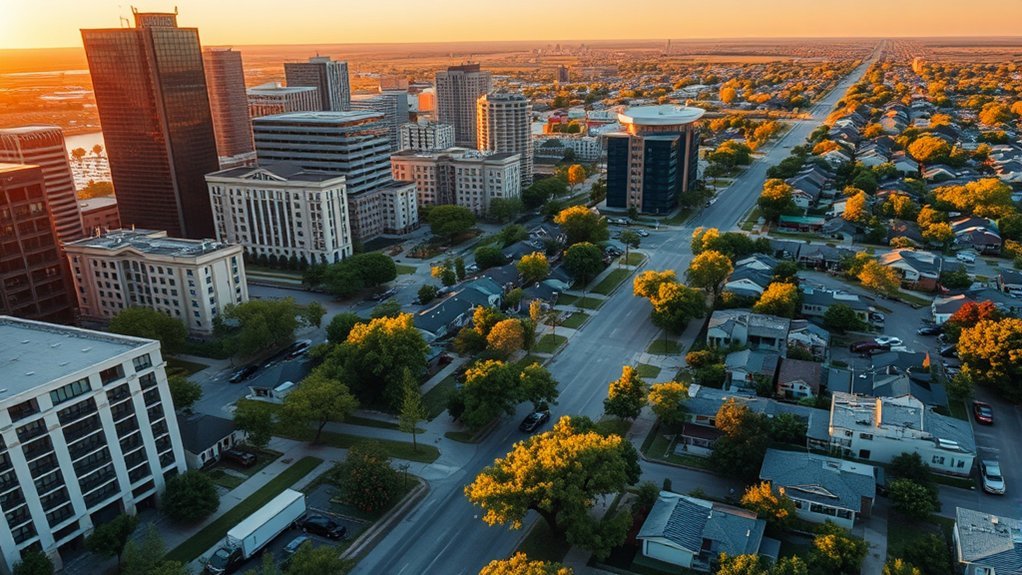If you’re planning a move to Oklahoma City, you’ll want to know what your monthly budget really looks like. On average a single adult spends about $3,533 per month, with one-bedroom rent near $1,153 (as of July 2025, Apartment List, 2025-07) and essentials like groceries and utilities adding several hundred dollars more. Healthcare and transportation also matter, and neighborhood choice can cut—or raise—your costs considerably, so keep going to see the numbers and what income you’ll need.
Monthly Budget Breakdown for a Single Adult

Budgeting in Oklahoma City is straightforward: a single adult’s average monthly expenses run about $3,533, roughly 25.9% below the national renter average.
You’ll see that the average monthly breakdown centers on a clear set of categories: rent in Oklahoma City, groceries in Oklahoma, utilities in Oklahoma, transportation in Oklahoma City, and miscellaneous essentials.
Expect about $1,153 for a one-bedroom rental (Apartment List, 2025-07), $657 on groceries, and $366 for utilities covering electricity and water.
Expect roughly $1,153 for a one-bedroom (Apartment List, 2025-07), $657 for groceries, and $366 for utilities monthly.
Transportation costs — gasoline and maintenance — average roughly $349 monthly.
Those figures let you model a realistic monthly budget and compare line items against national benchmarks, revealing lower spending across housing, food, utilities, and transport.
Use these concrete numbers to plan savings targets, emergency funds, or discretionary spending.
When you total them, the overall cost of living stays noticeably below U.S. averages, making it easier to align income with lifestyle goals without sacrificing essentials.
Typical Rent and Housing Costs by Neighborhood

Now that you’ve seen a typical monthly budget, it helps to look neighborhood-by-neighborhood where those housing numbers come from. You’ll find the average rent for a one-bedroom apartment in Oklahoma City is about $1,153 and two-bedroom apartments average $1,482 (as of July 2025, Apartment List, 2025-07).
Central neighborhoods like Midtown and Bricktown push those figures higher, while affordable options exist in Greenvale, Jones, Mustang, and Forest Park.
When comparing housing expenses, note rentals in the cheapest areas can start near $664 for a 1-bedroom in Greenvale, with some units under $700 (Rent.com, accessed 2025-10-13).
If you’re considering buying, the average home value in Oklahoma City is around $203,896 (Zillow Home Value Index, Zillow, accessed 2025-10-13) and the median listing price is about $299,900 (Realtor.com, 2025-08), both well below the national average.
Groceries, Utilities, and Essential Bills

You’ll see groceries run about $657 monthly for renters and $1,305 for homeowners—roughly 5.1% below the national average—so factor household size and shopping habits into your grocery budget.
Expect utilities around $366 for renters and $815 for homeowners, with a 915-ft² apartment’s basic utilities at about $232.79 plus ~$84.67 for internet (Numbeo, last updated 2025-10-07).
Don’t forget monthly essentials like healthcare ($149 renters / $415 homeowners) and transportation ($349 renters / $737 homeowners) when you make your checklist.
Grocery Cost Breakdown
Although groceries and utilities can vary by household size and housing type, you’ll find Oklahoma City generally costs less than the national average.
For grocery cost planning, expect an average monthly bill of about $657 if you’re a renter and $1,305 if you’re a homeowner — roughly 5.1% lower than the national figure. Those food costs reflect household scale: single adults spend less, families more.
Include essential expenses like basic utilities and healthcare when budgeting; renters typically add about $366 monthly for essential utility costs and homeowners about $815.
Basic utilities for a typical 915-square-foot apartment run near $232.79, with internet around $84.67 (Numbeo, 2025-10-07).
When you combine groceries with transportation and healthcare, your total essentials stay modest compared with many U.S. cities.
Monthly Utility Averages
Having looked at grocery costs, let’s cover typical monthly utilities and other must-pay bills so you can round out a realistic budget.
In Oklahoma City you’ll see clear monthly utility averages: renters pay about $366 for utilities while homeowners face around $815, both slightly below national norms.
Essential utility expenses—electricity and internet—combine to roughly $317.46 for a typical household (~$232.79 + ~$84.67; Numbeo, 2025-10-07).
Include groceries ($657 renters, $1,305 homeowners), healthcare ($149 renters, $415 homeowners) and transportation ($349 renters, $737 homeowners) to model total essential expenses.
These figures show homeowners generally carry higher monthly costs, especially for groceries and utilities.
Use these data-driven averages to adjust your budget projections and identify where you can trim recurring bills.
Essential Bills Checklist
Start with a clear checklist of the essentials so you can build a realistic monthly budget: groceries, utilities, transportation, healthcare, and housing are the core recurring costs to track.
Use local numbers to populate your plan: the average grocery cost in Oklahoma City is about $657/month for renters and $1,305 for homeowners, roughly 5.1% below the national average.
Monthly utility expenses run near $366 for renters and $815 for homeowners, about 3.2% cheaper than nationwide.
Factor transportation ($349 renters, $737 homeowners) and healthcare in Oklahoma ($149 renters, $415 homeowners).
Rent and other essential bills together bring a single adult’s essentials to roughly $3,533/month, reflecting a cost of living index about 25.9% lower than the U.S. average.
Healthcare, Insurance, and Medical Expenses

When you’re budgeting for living in Oklahoma City, plan on healthcare adding a modest but noticeable monthly line item — renters average about $149 a month while homeowners spend roughly $415.
You should treat healthcare and insurance as predictable parts of your budget: the typical monthly healthcare cost aligns with those figures, and annual medical expenses for a single adult average about $3,208, close to the national mean.
Treat healthcare and insurance as steady budget items: expect about $3,208 annually for a single adult, near the national average.
A routine doctor’s visit runs about $149.53 and a dentist appointment averages $124.67, so factor occasional visits into your cash flow. Prescription medications are affordable for many common drugs — ibuprofen costs about $10.92.
Access to care is widespread, and you can find subsidized or standard plans through HealthCare.gov.
Prioritize a plan that balances premiums, deductibles, and out-of-pocket caps to limit unexpected medical expenses and keep your monthly budget steady.
Transportation and Commuting Costs

Healthcare and insurance shape your monthly budget, but transportation often takes an even larger bite — renters in Oklahoma City spend about $349 per month on transportation while homeowners average $737.
Those figures reflect commuting expenses, maintenance and fuel; gasoline prices in Oklahoma have been around $2.58–$2.61 per gallon this month (AAA Oklahoma Avg, 2025-10-09; AAA State Averages, 2025-10-11), below the national average, which helps lower your variable costs. Many residents still rely on personal vehicles, so average transportation cost calculations should include routine service: even a tire balancing runs about $57.65.
If you drive, factor in annual car-based transportation costs estimated at $11,577 for 2025 across vehicle types (AAA “Your Driving Costs”, 2025-08) — those totals absorb depreciation, insurance, repairs and fuel.
Public transportation exists, but limited coverage means you’ll likely keep a car for daily commuting. To budget accurately, track miles, average MPG, insurance premiums and scheduled maintenance to forecast realistic monthly transportation costs and reduce unexpected commuting expenses.
Family and Childcare Expenses

Although childcare costs vary by age and provider, plan for a significant monthly outlay. Using Oklahoma’s latest market-rate data for child care centers, the mean infant full-time rate is $44.81/day and toddler rate is $42.17/day — roughly ~$970/mo and ~$915/mo if attending 5 days/week (OK DHS Child Care Market Rate Survey, 2024 Appendix A). Statewide, infant care remains a meaningful share of income (America’s Health Rankings summarizing CCAoA 2024, accessed 2025-10-13).
| Care Type | Avg Monthly Cost (est.) |
|---|---|
| Infant (center) | ~$970 (OK DHS Market Rate, 2024) |
| Toddler (center) | ~$915 (OK DHS Market Rate, 2024) |
Consider childcare variability when you build a monthly plan. Track provider fees, subsidies, and employer benefits to reduce out-of-pocket costs. Prioritize reliable care that supports both work and family responsibilities while keeping your budget realistic and data-driven.
What Salary You Need to Live Comfortably

Curious what salary will let you live comfortably in Oklahoma City? To cover basic living expenses and have some savings, aim for about $42,396 annually — roughly $3,533 per month. That estimate reflects Oklahoma City’s lower cost of living, about 18% below the national average, which reduces groceries, utilities, and transportation costs.
Curious about comfortable pay in Oklahoma City? Aim for roughly $42,396/year — about $3,533 monthly.
If you rent, the average monthly rent for a one-bedroom is about $1,153 (Apartment List, 2025-07), giving you room in your budget for other needs. Using the 30% rule, a safer target is $58,480 per year so housing doesn’t exceed your budget share.
Home prices and homeowner costs are also relatively affordable; owner costs vary by mortgage terms. For context, the U.S. median monthly owner costs with a mortgage were $2,035 in 2024 (U.S. Census Bureau, 2025-09-11), and Oklahoma City typically trends lower due to home values.
Decide whether to prioritize renting or buying, then budget accordingly. Compare the “salary do I need” figures against your personal debts, savings goals, and lifestyle to pick the right income target.
Frequently Asked Questions
How Much Money Do You Need to Live Comfortably in Oklahoma City?
You’d need about $42,400 annually to live comfortably. Factor affordable neighborhoods, salary expectations, grocery expenses, transportation costs, healthcare affordability, utility bills, and lifestyle choices to fine-tune your budget and maintain a stable, practical standard of living.
What Is the Average Cost of Living per Month in Oklahoma?
You’ll pay about $3,221 monthly. Housing expenses dominate, while transportation costs, grocery prices, utility bills, healthcare expenses, entertainment budget, and education fees all factor in—so you’ll plan carefully to keep finances steady.
Is $30 an Hour Good in Oklahoma?
Yes — you’re earning well: $30/hour beats the living wage, aids financial stability, and looks strong in salary comparison. Job opportunities and the housing market mean your cost analysis supports varied lifestyle choices and savings potential.
How Much of Monthly Income Should Rent Cost?
You should keep rent affordability near 30% of gross income; you’ll use budget planning and income allocation to balance housing expenses and savings, supporting financial stability. Use cost analysis and local rental market data to adjust.
Conclusion
You can live comfortably in Oklahoma City on a modest budget if you plan carefully and prioritize essentials. With average monthly costs around $3,533 — including $1,153 for one-bed rent (Apartment List, 2025-07), $657 groceries, $366 utilities, and $149 healthcare — you can see where to trim or reallocate spending. Want to build savings or handle unexpected expenses without stress? Use these figures to set a realistic salary target, track expenses monthly, and adjust choices by neighborhood.


